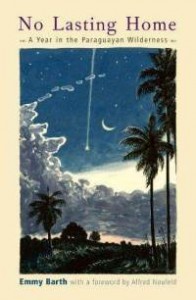ACCH Quarterly Vol. 15, No. 1, March 2010
Review of Emmy Barth, No Lasting Home. A Year in the Paraguayan Wilderness. Rifton, NY: Plough Publishing House, 2009. ISBN 978-0-87486-945-3
By John S. Conway, University of British Columbia
 In 1920 a Christian commune of pacifists was founded in Germany under the leadership of Eberhard Arnold, dedicated to the Anabaptist teachings of piety and non-violence, and repudiating the militarism and bloodshed which had so recently engulfed Europe. But this Brotherhood’s experiment aroused considerable opposition, which turned virulent under the Nazis. In 1937 the Gestapo expelled the community and forced them to flee to England.
In 1920 a Christian commune of pacifists was founded in Germany under the leadership of Eberhard Arnold, dedicated to the Anabaptist teachings of piety and non-violence, and repudiating the militarism and bloodshed which had so recently engulfed Europe. But this Brotherhood’s experiment aroused considerable opposition, which turned virulent under the Nazis. In 1937 the Gestapo expelled the community and forced them to flee to England.
They were helped to re-establish by the Quakers, and joined by a number of English pacifists who had obtained conscientious objector status. Nevertheless, after the outbreak of war in 1939, their situation became more difficult. The Brotherhood was convinced that part of their witness, both for German and English community members, was to remain together, living in love and harmony even when their two countries were at war. But as enemy aliens and pacifists they were no longer welcome. Curfews and travel restrictions were imposed. Debates as to whether the community should be allowed to exist were raised in Parliament. Late in 1940 they decided that they should all move again and seek refuge elsewhere. Since neither Canada nor the United States would accept them, they went instead to the only place which offered asylum, Paraguay. This short but vibrant reportage, drawn from the Brotherhood’s own records, is the story of their first year in the wilds of Latin America.
Emmy Barth, who is herself a descendant of these exiles, gives a wholly sympathetic picture of their experiences and the hardships they encountered in the harsh semi-tropical conditions of Paraguay. The Paraguayan government wanted more settlers in the remote and barren district of Chaco, and was prepared to offer the same privilege of exemption from military service, which had been extended to a group of German Mennonites who had moved to the Chaco some years earlier. In turn, the American Mennonite Central Committee offered the Brotherhood its support and some start-up costs.
But for these European refugees, trying to establish themselves as the guests of another tight-knit community, in the midsummer heat, and without any housing of their own, proved to be a real test of their faith. Worse still, they found, in these Mennonite communities, a considerable number of sympathisers with Hitler’s Germany, which was believed to have rescued Mennonites from the grip of Soviet Communism. The dark side of Nazi Germany was simply discounted by several leading members of the Chaco Mennonite community. So despite the close similarity of these communities’ origins and their Reformation faith, in fact tensions were constantly present. They were only resolved when the Brotherhood moved to a different and more pleasant part of Paraguay.
But the conditions were rigorous. Their numerous small children fell sick and several died. The men had to build their houses and meeting places from scratch, while the women were fully engaged in child care. Despite death and deprivation, however, the joy of building a new community in a new land was never entirely quenched. Through all the hardships, their faith in each other and in their witness was maintained. The numerous surviving photographs printed in this book, showing these home-made villages and their community activities, give a vivid portrait of this rural exile existence. Their main objective was the survival of the Brotherhood, and in this they succeeded. Twenty years later, when conditions improved, the Brotherhood emigrated to the United States where it still upholds its ideals today.
Emmy Barth is to be commended for her compassionate account of this short episode, which captures the courage and faithfulness of the community, and conveys something of the spirit which inspired and still inspires them.
